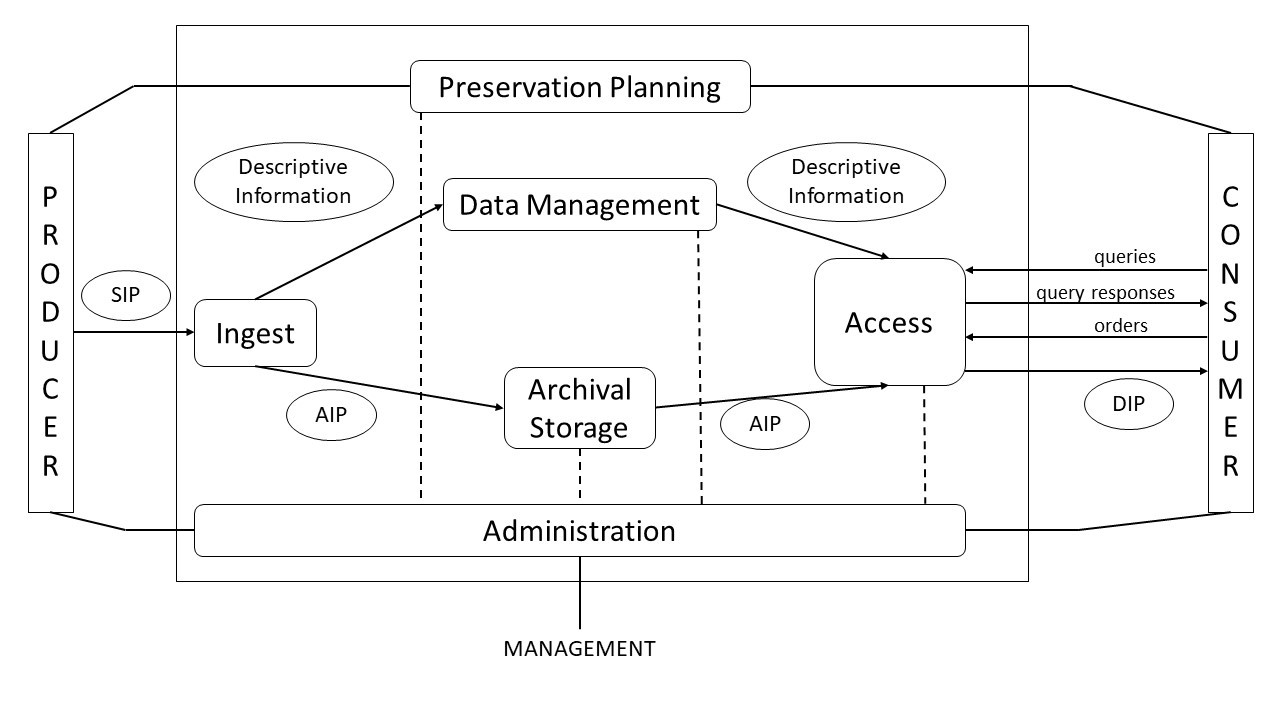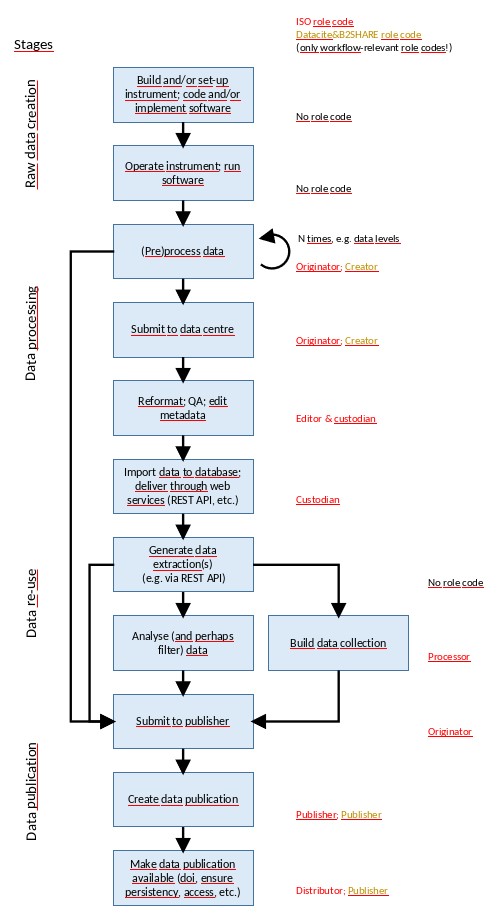2. Mapping TOAR Data Centre to the OAIS Model
In this section we will map from a high-level perspective relevant components of our archival system to the corresponding features of the OAIS model. The archival information system in the TOAR Data Centre context is the TOAR database with its API, its web service and its publication service.
2.1. The OAIS Functional Model
OAIS [1][2] is a reference model for ‘Open Archival Information Systems’. It has been accepted as a de facto standard for organisations with digital archiving requirements.

Fig. 2.1 OAIS Functional Entities
2.2. Functional Components
2.2.1. Ingest
In the ingestion process the data is curated and enriched by other metadata. Data is either sent to us by individual measurement stations or harvested from networks of measurement stations. The curated data and metadata of the individual data providers is sent back to the providers for approval before it is stored in the TOAR database. The data downloaded from networks is stored as is with the available metadata and enriched by quality indicators. Details of the ingestion process are documented in the Data Processing technical guide.
2.2.2. Archival Storage
The data is stored into a PostgreSQL (version 13) database. Write-Ahead Logging (WAL) is a standard method for ensuring data integrity. The build-in WAL mechanism of Postgres V13 is used. The TOAR database is backed up incrementally on a daily basis. Once a month, a base backup is created, on top of which a point-in-time recovery can be performed starting from the base backup up to the last backed up daily increment. The last two monthly base backups as well as the respective increments are kept on the system itself. The last deleted base backup as well as the corresponding increments are available through the backup system for another 30 days after deletion. A copy of the database is hold at RWTH Aachen (multicopy redundancy).
2.2.3. Data Management
The data is managed via mechanisms of the standard PostgreSQL tools (eg. vacuum). Reports are automatically created.
Additionally, workflows are in place for updating data and metadata in the database itself. Versioning of data and metadata is included in the processes to make the entries unique.
A REST API is available for accessing the data in the database. The requests are checked periodically to ensure satisfactory accessing times, which may result in optimising the database with PostgreSQL means (eg. indexing).
2.2.4. Preservation Planning
We distinguish two elements of data preservation here: (i) data preservation during the lifetime of the TOAR initiative and the operation of the TOAR DC, (ii) data preservation beyond the operation of the TOAR DC at JSC. The procedures for TOAR data preservation and the long-term data archival strategy are described in the TOAR_TG_Vol01_Infrastructure document.
2.2.5. Access
The TOAR Web Service provides access to the data in the TOAR database making use of the TOAR database API. The TOAR database API is accessible to all users.
The data in the TOAR database are freely available for read access. Authentication and authorization are only necessary for data ingestion (write access) and is provided through PostgreSQL roles.
(A higher-level access to TOAR data and other ozone data from external sources is provided through the TOAR data portal which links to the specific portals or access points of the different data sources.)
2.2.6. Administration
The TOAR Data Centre including its archival information system and its services are managed by the Jülich Supercomputing Centre (JSC) at Forschungszentrum Jülich.
All systems, networks, processes and performance are constantly monitored with Nagios. Operating system and software updates are regularly implemented.
2.2.7. Common Services
The TOAR database server is located on a virtual machine (VM) running Ubuntu inside an OpenStack cloud environment at Jülich Supercomputing Centre (JSC). It is guarded by a firewall and cannot be directly reached from the outside but only via the API service. The physical location of the data (tablespace) is mounted via NFS over a 10 GBit/s connection.
2.3. Information Packages
2.3.1. Submission Information Package
Data from individual providers must contain a specific set of metadata, which is documented in TOAR_UG_Vol05_Data_Submission_Guide. Data harvested from measurement station networks are taken as they are.
2.3.2. Archival Information Package
During the ingestion (or an update) process data and metadata are curated and quality controlled. They are stored in the database with version number and the history of changes.
2.3.3. Dissemination Information Package
TOAR’s API provides the extraction of data and metadata with flexible search options. Output formats are available in json and html. Derived data products can be generated via the API. The API also includes access to descriptive information from the ontology maintained for TOAR.
In case of data publication, the extracted data is augmented with the metadata required by the external B2SHARE service. The API URL to reproduce the dataset published in B2SHARE is stored in the data file’s metadata in the history tag and in the abstract of the B2SHARE record.
2.3.4. DOI Data Publication at TOAR Data Centre
In addition to the tasks as defined by OAIS a data publication workflow has been setup at TOAR DC. Data publication is the act of releasing data for (re)-use by others. The main objective is to elevate data to be first class research outputs. (https://en.wikipedia.org/wiki/Data_publishing)
For data from individual data submissions the ‘Ingest’ functional entity provides the data publication process at TOAR DC with DOI assignment. For more detail see TOAR_TG_Vol02_Data_Processing.
In this section we define the roles which are not described in OAIS in order to discriminate between the TOAR data publication process and the OAIS functions and roles.
Creator: Responsible for quality assurance of data and metadata with review criteria defined by publisher and community/project. Publisher: Responsible for editorial functions, including definition and assembly of metadata elements. Responsible for registration of DOI. Custodian: Party that accepts accountability and responsibility for the resource and ensures appropriate care and maintenance of the resource.
This describes our responsibilities as TOAR data centre team. Figure 3 below shows the ISO and the corresponding Datacite/B2SHARE role codes during the data processing workflow.

Fig. 2.2 TOAR data workflow and role codes
3. References
[1] Lavoie, B.F., 2004. The Open Archival Information System Reference Model: Introduction Guide. DPCTechnology Watch Series Report 04-01. Available at: http://www.dpconline.org/docs/lavoie_OAIS.pdf, last accessed 25 June 2021
[2] CCSDS Recommended Practice for an Oais Reference Model. Consultative Committee for Space Data Systems (CCSDS), Magenta Book 2012. Available at http://public.ccsds.org/publications/archive/650x0m2.pdf, last accessed 25 June 2021